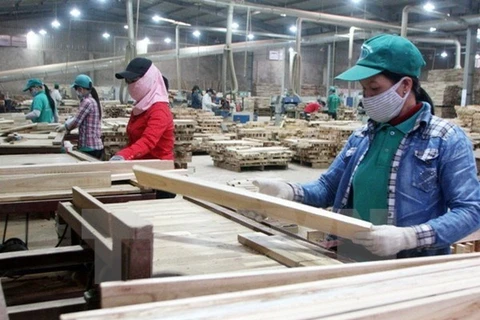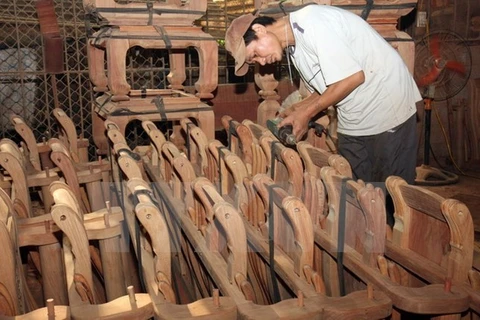Hanoi (VNA) - Experts forecast about 1 billion USD worth of timber to be exported to the EU annually by 2020 thanks to the EU-Vietnam Free Trade Agreement (EVFTA), according to an official of the Vietnam Timber and Forest Association.
Nguyen Ton Quyen, Vice Chairman and General Secretary of the association, said for many years, export value of timber and wooden products from Vietnam to EU reached at annual average about 650-700 million USD.
The EVFTA, expected to come into effect next year, will create a positive impact on the Vietnamese timber industry. At present, Vietnam’s timber and wooden products are exported mainly to Germany, France, Spain and Italy, but with EVFTA, the export market would be expanded to other EU member countries.
In fact, demand for timber products in the EU has been about 80-85 billion USD per year. That is much larger than Vietnam’s export value of timber and wooden products to the bloc.
EU timber processing technology boosts productivity by up to about 15-20 percent, he said. Under the EVFTA, together with a zero tax rate, businesses can more easily import machinery, equipment, and wood processing technology as well as learn corporate governance from the EU.
Quyen said the EU market had strict standards for exported timber and wooden products. A number of exporters in the northern region still do not know much about those standards and only about half a dozen have qualified to export their products to the EU. Meanwhile, hundreds of businesses in the central and southern regions have knowledge about those standards and EVFTA.
To take full advantages from the agreement in exporting goods to the EU, businesses need to constantly learn, update information and improve themselves.
Total Vietnamese exports of wood and timber products are expected to hit 8 billion USD in 2017, surpassing the yearly target of 7.5 billion USD, Quyen said.
The figure reached nearly 7 billion USD in January-November, up 10.5 percent from the same period last year, he said.
Strong growth in wood exports was seen in key markets such as the US (up 18.8 percent), the Republic of Korea (14.2 percent) and Canada (13.4 percent). The trend was attributed to an increase in processed wooden products, such as MDF (medium-density fibre board), particle board and artificial board.
To Xuan Phuc from the US-based Forest Trends, said Vietnam’s wood and timber exports to the US, currently worth up to 2.7 billion USD, might be affected by the US’s policy of creating more jobs in the US.
The US, Japan, the EU, China and the Republic of Korea are the biggest importers of Vietnam’s timber and wooden products, accounting for 90 percent of the total value of the sector. The US imports 42.7 percent, followed by China (14.1 percent) and Japan (13.7 percent).-VNA
Nguyen Ton Quyen, Vice Chairman and General Secretary of the association, said for many years, export value of timber and wooden products from Vietnam to EU reached at annual average about 650-700 million USD.
The EVFTA, expected to come into effect next year, will create a positive impact on the Vietnamese timber industry. At present, Vietnam’s timber and wooden products are exported mainly to Germany, France, Spain and Italy, but with EVFTA, the export market would be expanded to other EU member countries.
In fact, demand for timber products in the EU has been about 80-85 billion USD per year. That is much larger than Vietnam’s export value of timber and wooden products to the bloc.
EU timber processing technology boosts productivity by up to about 15-20 percent, he said. Under the EVFTA, together with a zero tax rate, businesses can more easily import machinery, equipment, and wood processing technology as well as learn corporate governance from the EU.
Quyen said the EU market had strict standards for exported timber and wooden products. A number of exporters in the northern region still do not know much about those standards and only about half a dozen have qualified to export their products to the EU. Meanwhile, hundreds of businesses in the central and southern regions have knowledge about those standards and EVFTA.
To take full advantages from the agreement in exporting goods to the EU, businesses need to constantly learn, update information and improve themselves.
Total Vietnamese exports of wood and timber products are expected to hit 8 billion USD in 2017, surpassing the yearly target of 7.5 billion USD, Quyen said.
The figure reached nearly 7 billion USD in January-November, up 10.5 percent from the same period last year, he said.
Strong growth in wood exports was seen in key markets such as the US (up 18.8 percent), the Republic of Korea (14.2 percent) and Canada (13.4 percent). The trend was attributed to an increase in processed wooden products, such as MDF (medium-density fibre board), particle board and artificial board.
To Xuan Phuc from the US-based Forest Trends, said Vietnam’s wood and timber exports to the US, currently worth up to 2.7 billion USD, might be affected by the US’s policy of creating more jobs in the US.
The US, Japan, the EU, China and the Republic of Korea are the biggest importers of Vietnam’s timber and wooden products, accounting for 90 percent of the total value of the sector. The US imports 42.7 percent, followed by China (14.1 percent) and Japan (13.7 percent).-VNA
VNA
























